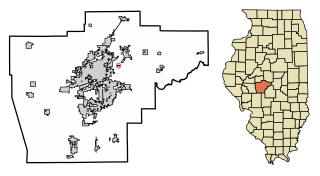
Springfield is the capital of the U.S. state of Illinois and the county seat of and most populous city in Sangamon County. The city's population was 114,394 at the 2020 census, which makes it the state's seventh most-populous city, the second largest outside of the Chicago metropolitan area, and the largest in central Illinois. Approximately 208,000 residents live in the Springfield metropolitan area.

Sangamon County is located in the center of the U.S. state of Illinois. According to the 2020 census, it had a population of 196,343. Its county seat and largest city is Springfield, the state capital.

Elkhart is a village in Logan County, Illinois, United States. The population was 405 at the 2010 census.

Harristown is a village in Macon County, Illinois, United States. The population was 1,310 at the 2020 census. It is included in the Decatur, Illinois Metropolitan Statistical Area.

Auburn is a city in Sangamon County, Illinois, United States. The population was 4,771 at the 2010 census, and 4,681 in 2018. It is part of the Springfield, Illinois Metropolitan Statistical Area.

Clear Lake is an unincorporated community and former incorporated village in Sangamon County, Illinois, United States. The population was 267 at the 2000 census. It is part of the Springfield, Illinois Metropolitan Statistical Area.

Romeoville is a village in Will County, Illinois, United States. The village is located 26 mi (42 km) southwest of Chicago on the Gateway Wetlands, directly west of the Des Plaines River. Per the 2020 census, the population was 39,863. It is located in the southwest suburban area of Chicago near Interstate 55 and Interstate 355.

The Illinois State Capitol, located in Springfield, Illinois, houses the legislative and executive branches of the government of the U.S. state of Illinois. The current building is the sixth to serve as the capitol building since Illinois was admitted to the United States in 1818. Built in the architectural styles of the French Renaissance and Italianate, it was designed by Cochrane and Garnsey, an architecture and design firm based in Chicago. Ground was broken for the new capitol on March 11, 1868, and the building was completed twenty years later for a total cost of $4.5 million.
New City is an unincorporated community in Cotton Hill Township, Sangamon County, Illinois, United States, in the rural center of the state. It is part of the Springfield, Illinois Metropolitan Statistical Area.
Glenwood High School is a public high school in Chatham, Illinois, United States. It is the only high school in Ball Chatham Community Unit School District 5, which is in southern Sangamon County and includes Chatham, Glenarm, and the southern portion of Springfield, Illinois.

The Old State Capitol State Historic Site, in Springfield, Illinois, is the fifth capitol building built for the U.S. state of Illinois. It was built in the Greek Revival style in 1837–1840, and served as the state house from 1840 to 1876. It is the site of candidacy announcements by Abraham Lincoln in 1858 and Barack Obama in 2007. It was designated a National Historic Landmark in 1961, primarily for its association with Lincoln and his political rival Stephen Douglas.

U.S. Route 66 was a United States Numbered Highway in Illinois that connected St. Louis, Missouri, and Chicago, Illinois. The historic Route 66, the Mother Road or Main Street of America, took long distance automobile travelers from Chicago to Southern California. The highway had previously been Illinois Route 4 and the road has now been largely replaced with Interstate 55 (I-55). Parts of the road still carry traffic and six separate portions of the roadbed have been listed on the National Register of Historic Places.

Lake Springfield is a 3,965-acre (16.05 km2) reservoir on the southeast edge of the city of Springfield, Illinois. It is 560 ft (170 m) above sea level. The lake was formed by building Spaulding Dam across Sugar Creek, a tributary of the Sangamon River. It is the largest municipally-owned body of water in Illinois. The lake and the lands adjoining it are all owned by City Water, Light & Power, the municipal utility for the city of Springfield, which operates the Dallman Power Plant at the lake's north end.

Ball Township is located in Sangamon County, Illinois. As of the 2010 census, its population was 6,701 and it contained 2,403 housing units. The township's offices are located in Glenarm. Portions of the village of Chatham are located in this township. Portions of Lake Springfield are also located in the township, including the former site of the flooded town of Cotton Hill.

Sugar Creek, a tributary of the Sangamon River, is a large creek in central Illinois, United States. It rises in Talkington Township in southwestern Sangamon County, flows briefly through northeastern Macoupin County, and then runs northeastward through south-central Sangamon County before discharging into Lake Springfield. The creek drains Auburn and Virden, Illinois and has a total length of 52.8 miles (85.0 km).

Toronto is a neighborhood of Springfield, Illinois and a former unincorporated rural community located in Woodside Township. Originally named for a station on the Illinois Central Railroad, it is located adjacent to what is now the "Toronto Road" exit at Mile 90 of the Illinois section of Interstate 55. Today, the Toronto neighborhood of Springfield is roughly defined as the region bordering Lake Springfield south of Interstate 72 and east of Interstate 55.
Riddle Hill is a rural unincorporated community located in Curran and Gardner townships, Sangamon County, Illinois. It is a crossroads located adjacent to where Old Jacksonville Road crosses Little Spring Creek, 6.5 miles west of Springfield.
Buffalo Hart is an unincorporated community in northern Sangamon County in the U.S. state of Illinois. It is the population center of its own township, Buffalo Hart Township.
Cotton Hill is a fictional character on the television series King of the Hill.

















